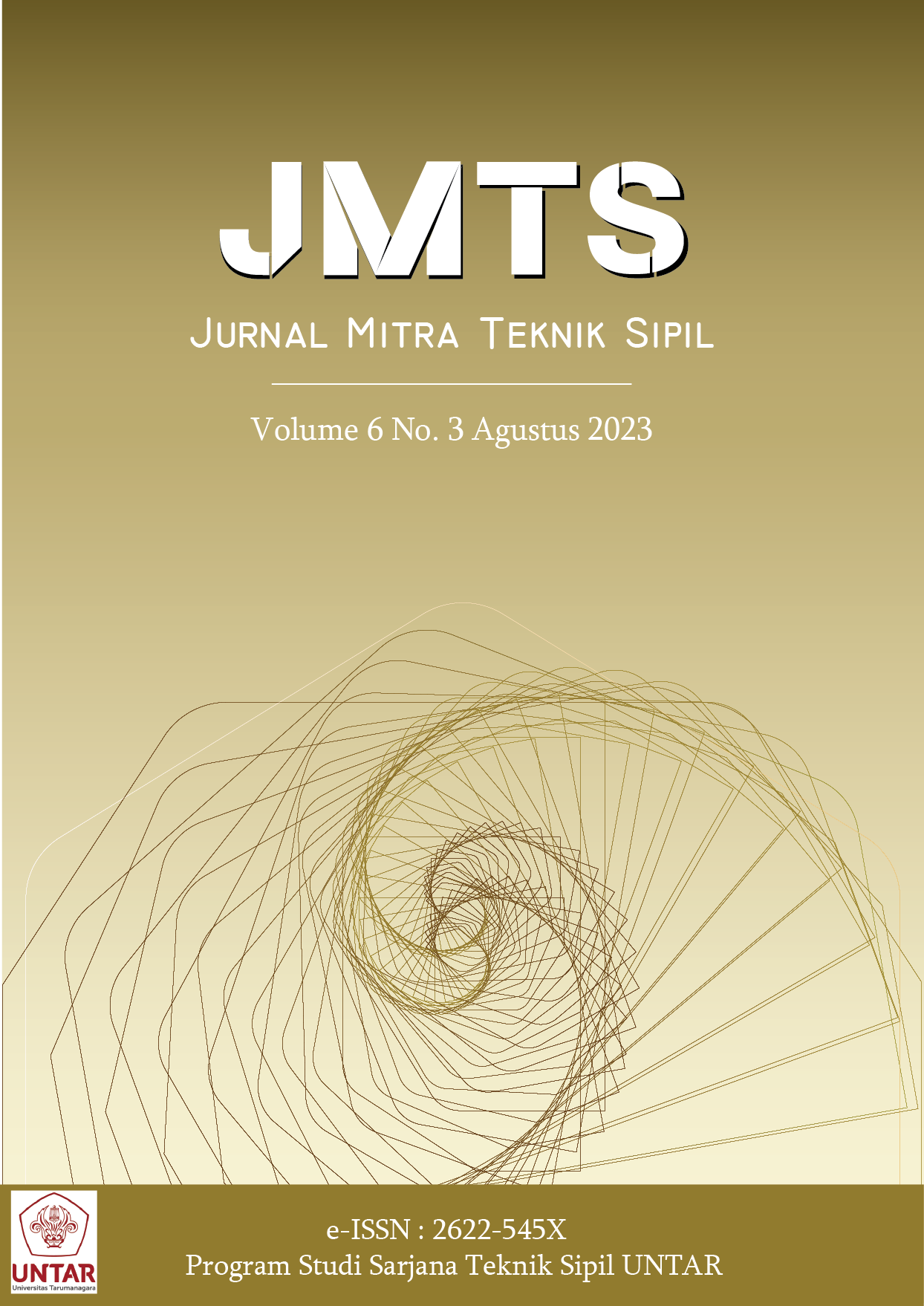STUDI KORELASI MUAI SUSUT TANAH EKSPANSIF DI DAERAH KARAWANG DAN CIKARANG
Main Article Content
Abstract
Expansive soil is a soil that easily expands and shrinks when there is a change in moisture content. The nature and characteristics of expansive soil have a dangerous impact on building structures such as foundation failure and cracking. This research will approach the correlation of soil parameters that have not been tested in the laboratory to obtain values that are close to field tests. In addition, it classifies the soil type into a certain level of expansiveness based on the approach taken. In this study, it was found that the expansive soils in each project have a development potential of "high-very high" based on the activity value with the percentage of clay grain fraction. Furthermore, based on the plasticity index relationship, the soils in all three projects have a development potential at the "very high" level. In addition, it was identified that the soils of the three projects have montmorrillonite mineral which validates that the soil type belongs to expansive soil type. The relationship of the parameters LL, PL and PI to swelling pressure (Psw) resulted in linear regression equations Psw = -0.0086 LL + 0.8268, Psw = -0.0139 PL + 0.5369, and Psw = -0.004 PI + 0.1619.
Abstrak
Tanah ekspansif merupakan tanah yang mudah mengalami kembang susut ketika terjadi perubahan kadar air. Sifat dan karakteristik tanah ekspansif ini memiliki dampak berbahaya bagi struktur bangunan seperti kegagalan fondasi dan keretakan. Pada penelitian ini akan dilakukan pendekatan terhadap korelasi parameter tanah yang belum diuji laboratorium untuk memperoleh nilai yang mendekati uji di lapangan. Selain itu, mengklasifikasikan jenis tanah termasuk ke dalam tingkat keekspansifan tertentu berdasarkan pendekatan yang dilakukan. Pada penelitian ini, diperoleh bahwa tanah ekspansif pada setiap proyek memiliki potensi pengembangan dari “high–very high” berdasarkan nilai aktivitas dengan persentase fraksi butiran lempun. Kemudian, berdasarkan hubungan indeks plastisitas tanah pada ketiga proyek memiliki potensi pengembangan pada tingkat “sangat tinggi”. Selain itu, diidentifikasi bahwa tanah dari ketiga proyek memiliki mineral montmorrilonite yang memvalidasi bahwa jenis tanah termasuk ke dalam jenis tanah ekspansif. Hubungan parameter-parameter LL, PL dan PI terhadap swelling pressure (Psw) menghasilkan persamaan regresi linier Psw = -0,0086 LL + 0,8268, Psw = -0,0139 PL + 0,5369, dan Psw = -0,004 PI + 0,1619.
Article Details
Section

This work is licensed under a Creative Commons Attribution-NonCommercial-ShareAlike 4.0 International License.
This work is licensed under Jurnal Mitra Teknik Sipil (JMTS) Creative Commons Attribution-ShareAlike 4.0 International License.References
Adianto C., W., & Susilo, A. J. (2019). Analisis penggunaan micropile untuk meminimalkan heaving pada tanah ekspansif di Jawa Barat. JMTS: Jurnal Mitra Teknik Sipil, 2(3), 145-151. https://doi.org/10.24912/jmts.v2i3.5818
Chen, F. H. (1975). Foundation on expansive soils. Elsevier Scientific Publiching Company.
Coduto, D. P. (1999). Geotechnical engineering principles and practices. Prentice-Hall, Inc.
Das, B. M., & Sivakugan, N. (2019). Principles of foundation engineering (Edisi 9). Cengage Learning Inc.
Snethen, D. R. (1975). A review of engineering experiences with expansive soils in highway subgrades. Federal Highway Administration.
Hardiyatmo, H. C. (2017). Tanah ekspansif: Permasalahan dan penanganan (Edisi 2). Gadjah Mada University Press.
Seed, H. B., Woodward, R. J., & Lundgren, R. (1962). Prediction of swelling potential for compacted clays. Journal of the Soil Mechanics and Foundations Division, 88(3) https://doi.org/10.1061/JSFEAQ.0000431
Skempton, A. W. (1953). The colloidal activity of clays. 3rd International Conference on Soil Mechanics and Foundation Engineering, London, 57-61.
Uniform Building Code. (1968). Uniform building code standard. Department of Citywide Administrative Services.

